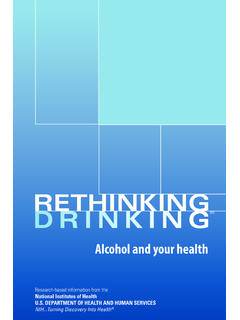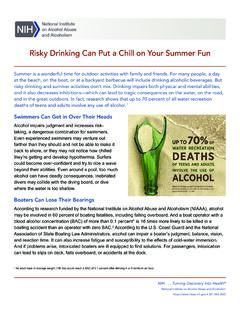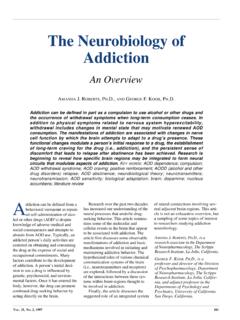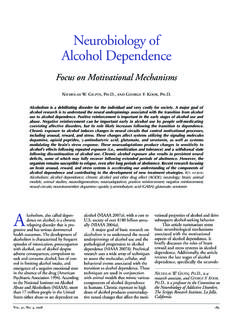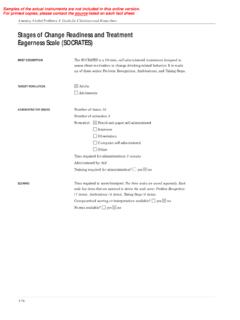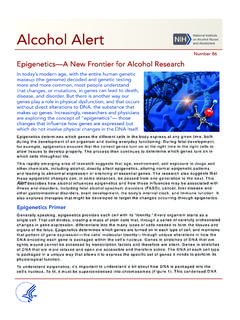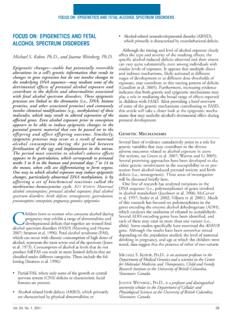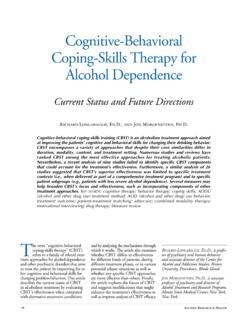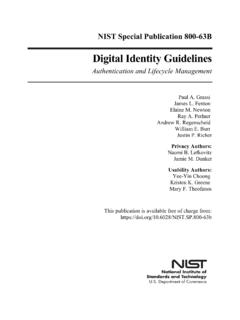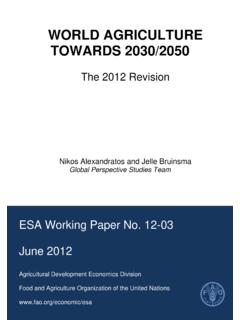Transcription of Social and Psychological Influences on Emerging Adult ...
1 Alcohol Research & Health 182 Social and Psychological Influences on Emerging Adult Drinking Behavior Helene Raskin White, , and Kristina Jackson, HELENE RASKIN WHITE, , is a professor at the Center of Alcohol Studies, Rutgers, The State University of New Jersey, in Piscataway, New Jersey. KRISTINA JACKSON, , is a research assistant professor in the Department of Psychological Sciences, University of Missouri Columbia, Columbia, Missouri. Work on this paper was supported by National Institute on Drug Abuse grants DA 17552 and DA 17842, and by National Institute on Alcohol Abuse and Alcoholism grant AA 13938. Emerging adulthood, the transitional period between high school and young adulthood, is marked by the formation of identity, the establishment of more mature interpersonal and intimate relationships, and the transition to new Adult type roles. It also is a time of increased alcohol use and abuse, which can have long term effects on both physical and Psychological well being and may have implications for the attainment of traditional Adult roles.
2 Gender, race/ethnicity, marital status, college, employment, peer and family Influences , individual temperament, and attitudes about drinking all influence drinking behavior in this population. Attending college may represent a special risk to Emerging adults, as increases in alcohol availability and acceptance of drinking on college campuses may lead to increases in heavy drinking among students. The nonstudent population of Emerging adults also is an important target for preventive interventions, especially because people in this segment of the population may be less likely to mature out of heavy drinking patterns established during adolescence. Thus, the transition from high school to young adulthood appears to be an ideal developmental turning point during which to target interventions. KEY WORDS: young Adult ; young adulthood; undergraduate student; drinking behavior; AOD (alcohol and other drug) use, abuse and dependence; heavy drinking; AOD use pattern; causes of AODU (alcohol and other drug use); AOD effects and consequences; AODR (alcohol and other drug related) interpersonal and societal problems; intervention; prevention; Social costs and benefits of AOD; Social behavior; perception of norms Arnett (2000) referred to the transitional period from high school to young adulthood as Emerging adulthood.
3 This stage of life is defined as the period from the end of secondary school through the attainment of Adult status (Arnett 2005), covering approximately ages 18 to 25, although it can extend longer. Emerging adulthood is marked by frequent change and explo ration. It also is a period of increased alcohol use and abuse (Arnett 2000; Bachman et al. 1997). This article examines the develop mental changes and related drinking patterns and problems that occur during Emerging adulthood and the sociodemo graphic and psychosocial factors that influence drinking in this population. It concludes with a discussion of the impli cations of this research for prevention. Emerging Adulthood Numerous historical changes have caused Emerging adulthood to become a distinct period in the life course in industrial ized countries. One major contributor is the fact that people are waiting longer before marrying.
4 In the United States, the median age of marriage increased from 20 for women and 22 for men in 1950 to 25 for women and 27 for men in 2000 (Arnett 2005). Several reasons may account for this delay in marriage, including more people seeking college and postgraduate education, the inven tion of the birth control pill and changing standards of sexual morality, changes in women s roles, and an increased desire Social and Psychological Influences for independence and freedom among youth (Arnett 2005). Emerging adulthood is marked by a variety of developmental tasks, including identity formation and the establishment of more mature interpersonal and inti mate relationships (Arnett 2000; Schul enberg and Maggs 2002). During this period, young people also obtain the education and training needed for future careers. These tasks must be completed to make a successful transition to Adult hood, and failure to master them can result in frustration and stress, which can lead to a variety of unhealthy behaviors, including increased alcohol use.
5 Para doxically, alcohol use can impede the suc cessful mastery of these developmental tasks and may exacerbate failures and increase stress (Schulenberg et al. 2003). Emerging adulthood often is char acterized by changes in residence, employment or education, and roman tic relationships. It is a time of identity exploration and self focus; initiation of new roles; development of new Social networks; separation from families and old friends; increased choices and oppor tunities; increased independence; freedom from time constraints and Social con trol; and decreased parental support, guidance, and monitoring (Arnett 2005; Schulenberg and Maggs 2002). Arnett (2005) has suggested that increases in drinking during Emerging adulthood are normative in Western society because of the many develop mental changes taking place at this age. Social control lessens during this period, and people become freer to choose behaviors ( , heavy drinking) and lifestyles that are not constrained by others.
6 Along with identity exploration and trying out various behaviors, emerg ing adults may seek out the altered states of consciousness that different substances can induce. In addition, constructing a stable identity can be confusing and difficult, and some Emerging adults may use substances to relieve their identity confusion. Emerging adulthood also is a period of instability, and people often are involved in unstable Social networks. Clearly, no one set of norms governs drinking behavior. People are free to make their own decisions independently and to do things that may not be accept able in either adolescence or young adulthood,1 including using illegal sub stances. In sum, the developmental changes taking place during Emerging adulthood can lead to increased drink ing as a means of dealing with greater stress or as a result of the increased free dom that allows Emerging adults to drink heavily.
7 In addition, the weakening of parental monitoring and increased importance of peer relationships can lead to increased alcohol consumption (Borsari and Carey 2001) (see the sec tion Peer Influences , below). Finally, in the United States, at age 21 people can legally obtain and consume alcohol, which contributes to increased access and opportunities to use alcohol. Drinking Patterns and Problems During Emerging Adulthood Many people begin to use alcohol before they graduate from high school. However, peak use of alcohol occurs during Emerging adulthood, and this excessive drinking appears to be normative behavior. In North America and many other industrialized societies, binge2 or excessive drinking during Emerging adulthood is condoned, and perhaps even encouraged, particularly for those attending college (Arnett 2005). data from the Monitoring the Future (MTF) study across several years indicate that 30 day prevalence (use in the last 30 days) peaks at ages 21 22 (at 85 percent for men and 76 percent for women), and heavy drinking (drinking five or more drinks in a row in the past 2 weeks) peaks at ages 21 22 for men (at 55 percent) and at ages 19 20 for women (at 33 percent) and then declines linearly into young adulthood (Bachman et al.)
8 1997). Drinking during Emerging Adult hood can serve positive functions, such as facilitating friendship formation, but people also experience high rates of alcohol related problems during this period. For example, people ages 18 to 29 have the highest rates of past year alcohol abuse and dependence (Grant et al. 2004). Alcohol related problems during Emerging adulthood can have long term effects on physical and psy chological well being (Schulenberg et al. 2003) and can have implications for the attainment of traditional Adult roles ( , heavy drinking leads to poor aca demic outcomes, which in turn lead to less favorable occupational opportunities). Numerous studies have identified problems related to alcohol use, includ ing fatal and nonfatal injuries and over doses, academic/vocational failures, violence and other crime, unintended pregnancies, and sexually transmitted diseases (Perkins 2002a; Hingson et al.
9 2002), although the extent to which alcohol use causes some of these problems ( , academic problems) remains unclear (Jackson et al. 2005). Rather, alcohol use and problems during Emerging adulthood may be the result of some common factor (such as lower academic motivation, in the case of academic problems) (Schulenberg et al. 2003). Impaired driving, another seri ous problem associated with drinking, is especially prevalent among Emerging adults (Hingson et al. 2002). In addition, 1 Young adulthood is the period following Emerging Adult hood. It begins with the adoption of Adult roles, such as marriage, parenthood, and a stable occupational path. It generally begins in the late twenties and continues through the thirties (Arnett 2000). 2 Binge drinking is defined by the National Institute on Alcohol Abuse and Alcoholism as consuming five or more drinks for men, or four or more drinks for women in about 2 hours.
10 Vol. 28, No. 4, 2004/2005 183 Alcohol Use Among Emerging Adults Among people ages 21 22, 85 percent of men and 76 percent of women have used alcohol within the last 30 days (Bachman et al. 1997). 55 percent of men ages 21 22 and 33 percent of women ages 19 20 drank five or more drinks in a row in the past 2 weeks (Bachman et al. 1997). People ages 18 29 have the highest rates of past year alcohol abuse and depen dence (Grant et al. 2004). about half of college students report past year hangovers, nausea, and vom iting as a result of drinking, and about one fourth report blackouts (or mem ory loss while intoxicated) (Jackson et al. 2005). Furthermore, excessive drinkers can create problems for others, includ ing physical and sexual assaults, insults and humiliation, preventing others from studying/sleeping, and vandalism (Jackson et al. 2005; Perkins 2002a). Changes in Drinking During Emerging Adulthood The transition out of high school may be marked by increases in alcohol use and intoxication (Baer et al.)
